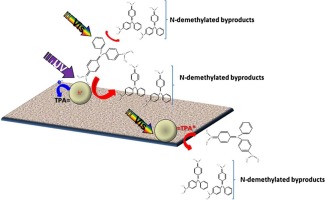Molecular Catalysis ( IF 4.6 ) Pub Date : 2018-02-21 , DOI: 10.1016/j.mcat.2018.01.015 Julián A. Rengifo-Herrera , Diego A. Marín-Silva , Edita Mendoza-Portillo , Adriana N. Pinotti , Luis R. Pizzio

|
Chitosan (CS) films containing visible light absorbing TiO2 nanoparticles modified with tungstophosphoric acid (TPA-TiO2) at different TPA-TiO2:CS ratios (10%, 20%, 30% and 40% (w/w) called CS/TPA-TiO2-10, CS/TPA-TiO2-20, CS/TPA-TiO2-30, and CS/TPA-TiO2-40 respectively) were prepared. Films were characterized by DRS, SEM-EDS, XRD, ATR-FT-IR, and contact angle (CA). Materials were evaluated in malachite green (MG) photobleaching solid-gas interface reactions upon different wavelengths.
SEM-EDS micrographs showed that TPA-TiO2 nanoparticles were well dispersed through the CS film. According to ATR-FT-IR results, the interactions between TPA-TiO2 nanoparticles and the CS functional groups were weak. Regarding the MG photobleaching reactions, CS/TPA-TiO2-30 film showed the highest activity upon UV-A + visible irradiation, which was even higher than that of chitosan films containing the same amount of Evonik P-25 (CS/P25-30). It was also observed by DRS that the main absorption band of malachite green underwent a hypsochromic shifting caused by oxidative reactions of N-demethylation. On the other hand, at wavelengths higher than 450 nm (Vis-1), CS/TPA-TiO2-30 films showed a marked dye photobleaching. Finally, upon irradiation at wavelengths above 590 nm (Vis-2), a slight color fading was observed. These results revealed that CS/TPA-TiO2-30 films were efficient in the photobleaching of malachite green in solid-gas interfaces through an oxidative path by photocatalytic and photosensitized routes. CS/TPA-TiO2-30 films showed high stability and MG photobleaching capacity after 5 reuse cycles.
中文翻译:

含钨磷酸修饰的TiO 2纳米粒子的壳聚糖膜,用于不同波长的固-气界面中孔雀石绿的光漂白
壳聚糖(CS)膜,包含用钨磷酸(TPA-TiO 2)改性的可见光吸收TiO 2纳米颗粒,TPA-TiO 2:CS比率不同(分别为10%,20%,30%和40%(w / w))分别制备了/ TPA-TiO 2 -10,CS / TPA-TiO 2 -20,CS / TPA-TiO 2 -30和CS / TPA-TiO 2 -40。通过DRS,SEM-EDS,XRD,ATR-FT-IR和接触角(CA)对薄膜进行表征。在孔雀石绿(MG)光漂白固-气界面反应中对不同波长的材料进行了评估。
SEM-EDS显微照片显示,TPA-TiO 2纳米颗粒很好地分散在CS膜中。根据ATR-FT-IR结果,TPA-TiO 2纳米粒子与CS官能团之间的相互作用较弱。关于MG的光漂白反应,CS / TPA-TiO 2 -30膜在UV-A +可见光照射下表现出最高的活性,甚至比包含相同量的Evonik P-25(CS / P25- 30)。通过DRS还观察到孔雀石绿的主要吸收带经历了由N-去甲基化的氧化反应引起的七色移。另一方面,在高于450 nm(Vis-1)的波长下,CS / TPA-TiO 2-30膜显示出明显的染料光致漂白。最后,在高于590 nm(Vis-2)的波长下照射时,观察到轻微的褪色。这些结果表明,CS / TPA-TiO 2 -30薄膜可通过光催化和光敏途径通过氧化途径有效地固溶气界面中孔雀石绿的光漂白。5次重复使用后,CS / TPA-TiO 2 -30薄膜显示出高稳定性和MG光漂白能力。

























 京公网安备 11010802027423号
京公网安备 11010802027423号